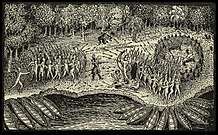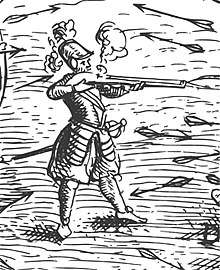Iroquois War (1609)
During the summer of 1609, Samuel de Champlain attempted to form better relations with the local native tribes. He made alliances with the Wendat (called Huron by the French) and with the Algonquin, the Montagnais and the Etchemin, who lived in the area of the St. Lawrence River. These tribes demanded that Champlain help them in their war against the Iroquois, who lived further south. Champlain set off with 9 French soldiers and 300 natives to explore the Rivière des Iroquois (now known as the Richelieu River), and became the first European to map Lake Champlain. Having had no encounters with the Iroquois at this point many of the men headed back, leaving Champlain with only 2 Frenchmen and 60 natives.
| Iroquois War | |||||||
|---|---|---|---|---|---|---|---|
| Part of the Beaver Wars | |||||||
| |||||||
| Belligerents | |||||||
|
| Algonquins, Etchemin, Montagnais, Huron | ||||||
| Commanders and leaders | |||||||
| Unknown | Samuel de Champlain, Iroquet and Ochateguin (Algonquins) | ||||||
| Strength | |||||||
| Between 200 and 300 warriors, three chiefs or “captains” |
Between 60 and 100 warriors, formerly 300 who turned back 3 French arquebusiers, formerly 9 | ||||||
| Casualties and losses | |||||||
| Between 50 and 100 killed, 12 taken prisoner and tortured | Unknown, but no more than 20 | ||||||


On July 29, somewhere between Canada and Northern US(Maine,Vermont,Connecticut) (historians are not sure which of these two places, but Fort Ticonderoga claims that it occurred near its site), Champlain and his party encountered a group of Iroquois. A battle began the next day. Two hundred Iroquois advanced on Champlain's position, and one of his guides pointed out the 3 Iroquois chiefs. Champlain fired his arquebus, killing two of them with a single shot, and one of his men killed the third. The Iroquois turned and fled after a hail of arrows were let of on both sides, as the Hurons and Algonquins routed the enemy, killing fifty and taking twelve prisoners, whom they tortured until death. This action set the tone for French-Iroquois relations for the rest of the century.[2]
References
- Fischer, p. 3
- In 1701, The Great Peace Treaty was signed in Montreal, involving the French and every native nation coming or living on the shores of the Saint Lawrence River except maybe in wintertime.